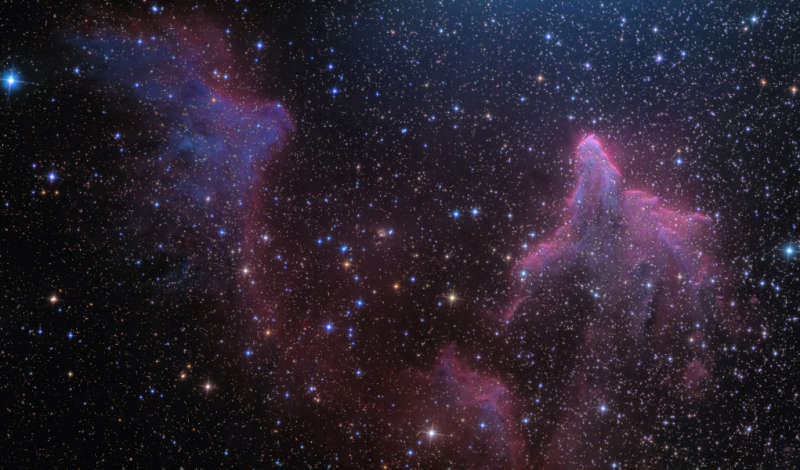
|
Credit & Copyright: Ken Crawford
(Rancho Del Sol Obs.)
Explanation:
These bright rims and flowing shapes suggest to some melting
ice cream on a cosmic scale.
Looking toward the constellation
Cassiopeia,
the colorful (zoomable) skyscape features
the swept back, comet-shaped clouds IC 59 (left) and IC 63.
About 600 light-years distant,
the clouds
aren't actually melting,
but they are slowly dissipating under the influence of
ionizing ultraviolet
radiation from hot,luminous star gamma Cass.
Gamma Cass is
physically located only 3 to 4 light-years from the
nebulae, just off the upper right edge of the frame.
In fact, slightly closer to gamma Cass,
IC 63 is dominated by
red H-alpha light emitted as the
ionized hydrogen atoms recombine with electrons.
Farther from the star, IC 59 shows proportionally less H-alpha
emission but more of the characteristic blue tint of dust
reflected star light.
The field of view spans about 1 degree or 10 light-years at the
estimated distance of
gamma Cass and friends.
|
January February March April May June July August September October November December |
| ||||||||||||||||||||||||||||||||||||||||||||||||
NASA Web Site Statements, Warnings, and Disclaimers
NASA Official: Jay Norris. Specific rights apply.
A service of: LHEA at NASA / GSFC
& Michigan Tech. U.
Based on Astronomy Picture
Of the Day
Publications with keywords: Cassiopeja - reflection nebula - emission nebula - H-alpha - ionization
Publications with words: Cassiopeja - reflection nebula - emission nebula - H-alpha - ionization
See also:
- APOD: 2024 May 1 Á IC 1795: The Fishhead Nebula
- APOD: 2024 April 24 Á Dragons Egg Bipolar Emission Nebula
- APOD: 2024 March 13 Á The Seagull Nebula
- APOD: 2024 February 21 Á Seagull Nebula over Pinnacles Peak
- NGC 1893 and the Tadpoles of IC 410
- The Light, the Dark, and the Dusty
- APOD: 2023 December 13 Á Deep Field: The Heart Nebula
